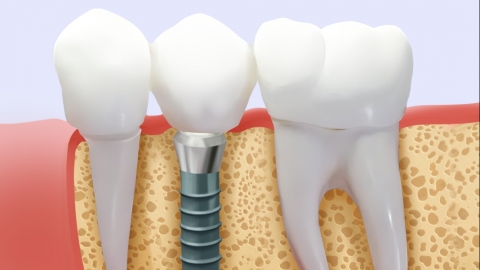Which is better between porcelain-fused-to-metal crowns and dental implants, and what are the differences?
Generally speaking, porcelain-fused-to-metal (PFM) crowns and dental implants are both common dental restoration methods. Both are effective but suitable for different situations. They differ in terms of restoration principles, impact on adjacent teeth, comfort and functional recovery, lifespan, cost, and other aspects. The detailed analysis is as follows:

1. Restoration Principles
Porcelain-fused-to-metal crowns usually utilize the healthy teeth on both sides of the missing tooth as abutment teeth, fixing the porcelain crown onto these abutment teeth to restore the shape and function of the missing tooth. This requires grinding down adjacent teeth to provide retention and support for the PFM crown, making it a fixed dental restoration method. Dental implants involve surgically placing an implant into the alveolar bone at the site of the missing tooth. After some time, the implant forms a strong osseointegration with the alveolar bone. A dental crown is then attached to the implant to restore the tooth's shape and function. This is an independent restoration method that does not rely on adjacent teeth.
2. Impact on Adjacent Teeth
Porcelain-fused-to-metal crowns require grinding down the natural teeth on both sides of the missing tooth, which causes irreversible damage to these adjacent teeth. After grinding, the adjacent teeth have reduced dental tissue, potentially leading to sensitivity, pulpitis, apical periodontitis, and other issues. Over time, the risk of caries in these adjacent teeth also increases. In contrast, dental implants do not damage neighboring natural teeth. They are placed independently within the alveolar bone at the edentulous area, preserving the patient's natural dental tissues to the greatest extent possible. This method does not affect the health of adjacent teeth and maintains the integrity and stability of the natural dentition.
3. Comfort and Functional Recovery
Porcelain-fused-to-metal crowns may cause a foreign body sensation initially, requiring some time to adapt. Since they rely on adjacent teeth for support, the force transmission during chewing differs from that of natural teeth, resulting in relatively limited functional recovery. If the abutment teeth develop problems, the entire PFM crown may need to be removed for treatment. Implants integrate closely with the alveolar bone, providing high stability. The shape and feel of the crown are similar to natural teeth, making the foreign body sensation minimal. In terms of functional recovery, implants can effectively restore oral masticatory function, allowing normal chewing of various foods and meeting the patient's daily dietary needs.
4. Lifespan
The lifespan of a porcelain-fused-to-metal crown is typically 10–15 years, although the exact duration is closely related to the health of the abutment teeth, the patient's oral hygiene habits, dietary habits, and other factors. If the abutment teeth become loose or decayed, the lifespan of the PFM crown may be shortened. With proper maintenance, dental implants can last more than 20 years, and even a lifetime.
5. Cost
Porcelain-fused-to-metal crowns are relatively less expensive overall, with costs mainly including abutment tooth preparation and crown fabrication fees. Prices vary depending on the selected materials. Dental implants are relatively more expensive, including the cost of the implant itself, surgical fees, crown costs, and potentially bone augmentation procedures. The price of implants varies significantly depending on brand and type.
When choosing between porcelain-fused-to-metal crowns and dental implants, one should comprehensively consider personal oral conditions, financial capacity, treatment duration, and other factors. Additionally, selecting a reputable dental hospital and experienced dentist is an important guarantee for ensuring treatment outcomes and safety.




